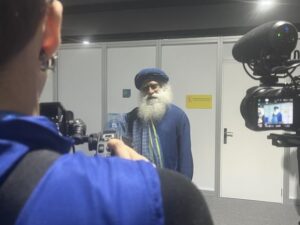
Arts, Biodiversity, Civil Society, Climate Action, Climate Change, COP29, COP29 Blog, Editors’ Choice, Environment, Featured, Global, Headlines, Sustainable Development Goals, TerraViva United Nations

Brad Wilson is an American photographer specializing in classical portraits of animals. Credit: Umar Manzoor Shah/IPS
As delegates at COP29 stroll through the venue in Baku, Azerbaijan, many pause to marvel at the stunning portraits of animals and birds adorning the pavilion walls. These 16 captivating images, showcasing Azerbaijan’s rich biodiversity, are more than just art—they’re a call to action.
Visitors, from diplomats to environmental activists, can often be seen snapping selfies with these majestic portraits, drawn to their lifelike intensity. Behind this collection is Brad Wilson, an American photographer whose mission is to “bridge the gap between humans and the natural world.”
Wilson spoke to the IPS on his artistic journey and the philosophy underpinning his work.
“My name is Brad Wilson,” he begins. “I’m an American photographer specializing in classical portraits of animals.”
Classical portraits—usually a domain of human subjects—take on a unique depth when applied to animals.
“I aim to elevate animals to a higher level, presenting them as equals to humans—different but equal. Looking into their eyes through these photographs should invoke a sense of responsibility for their lives because we all share the same planet.”
For Wilson, animals represent a poignant connection to the natural world. “They are our closest relatives living in the wild,” he says. “They serve as a bridge, reminding us of our roots in nature.”

Brad Wilson photographic portraits were commissioned for the Haydar Aliyev Centre in Baku and are on display at the COP29 venue. Credit: Umar Manzoor Shah/IPS
Process: A Dance of Patience and Precision
Creating these portraits is no simple task. Wilson describes the meticulous setup required for his work.
“All the portraits are done in a studio. I set up the studio close to where the animals live—often in sanctuaries or ranches. Then we bring them in for two or three hours,” he says. But those hours yield just fleeting moments of magic.
“I’m lucky if I get two or three good seconds with each animal. But that’s all I need—a single moment of connection that resonates.”
“My photo shoots are like meditations amidst organized chaos,” he says. Amid bustling activity, Wilson remains quiet and still, waiting for the animal to relax. “What I aim to capture is something uncommon—a glimpse of the animal’s soul, if you will. That’s what I hope viewers experience—a moment of connection.”
“I want people to understand that we are part of this planet’s biodiversity. We’re not separate from these creatures. It’s only been about 12,000 years—since the advent of farming and permanent settlements—that we began seeing ourselves as separate from the natural world. That’s a mistake. These animals remind us of our place in the web of life.”
“When we talk about climate action, it’s not just about saving the earth—it’s about saving humanity and the animals that share this planet with us. The earth will endure, but we might not.”
Behind the Scenes at COP29
Wilson’s collection at COP29 was commissioned by the Haydar Aliyev Centre in Baku.
“They brought me here in August to photograph animals in Baku and Shamaki,” he says. The project celebrates Azerbaijan’s biodiversity, showcasing species native to the region while promoting conservation awareness.
The portraits have been a hit among COP29 attendees, sparking conversations about the intersection of art, biodiversity, and climate action. Wilson hopes the images inspire policymakers and the public alike to take meaningful action.
“Climate change is already a massive problem, and it’s only going to worsen. We need to get serious about tackling it.”
Advice for Aspiring Photographers
For those inspired to follow in Wilson’s footsteps, he offers this advice: “Start with humans. I spent 15 years photographing people in New York City before transitioning to animals. That experience taught me about connection and emotion—skills that translate well to wildlife photography.”
IPS UN Bureau Report










